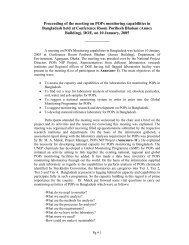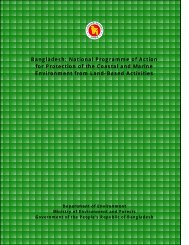Draft CMP HH - the Department of Environment
Draft CMP HH - the Department of Environment
Draft CMP HH - the Department of Environment
You also want an ePaper? Increase the reach of your titles
YUMPU automatically turns print PDFs into web optimized ePapers that Google loves.
Coastal and Wetland Biodiversity Management Project BGD/99/G31<br />
Hakaluki Haor <strong>Draft</strong> Conservation Management Plan<br />
7.2.14 Soils<br />
Understanding <strong>the</strong> soil pr<strong>of</strong>ile <strong>of</strong> Hakaluki Haor will provide important baseline information upon<br />
which to base management decisions especially in relation to <strong>the</strong> conservation <strong>of</strong> swamp forests and<br />
<strong>the</strong> sustainable production agricultural and horticultural crops in and around <strong>the</strong> Hakaluki Haor<br />
ECA.<br />
A comprehensive Mouza level soil pr<strong>of</strong>ile has already been developed by <strong>the</strong> Soil Research and<br />
Development Institute (SRDI). An in-depth technical analysis <strong>of</strong> this data is now necessary in order<br />
draw-out <strong>the</strong> linkages and relationships between soil variances in <strong>the</strong> ECA and <strong>the</strong> potential to<br />
regenerate swamp forests, as well as grow economically viable and environmentally sustainable<br />
agricultural and horticultural crops. A sound knowledge <strong>of</strong> soil characteristics will also be<br />
beneficial in attempting to address on-going issues <strong>of</strong> erosion and sedimentation.<br />
Management Actions<br />
• Analyse <strong>the</strong> soil pr<strong>of</strong>ile map developed by <strong>the</strong> Soil Research and Development Institute (SRDI)<br />
and undertake ground truthing missions to validate its accuracy<br />
• Provide support to SRDI in updating <strong>the</strong> soil pr<strong>of</strong>ile map<br />
• Identify <strong>the</strong> soils in which swamp forest species grow best and where <strong>the</strong>se soil types are located<br />
throughout <strong>the</strong> ECA<br />
• Develop an understanding <strong>of</strong> how soils and soil pr<strong>of</strong>iles are changing in Hakaluki Haor and<br />
determine <strong>the</strong> impact such change will have on <strong>the</strong> restoration <strong>of</strong> swamp forests and <strong>the</strong><br />
production <strong>of</strong> agricultural and horticultural crops<br />
Primary Outcome/ Output<br />
• The relationship between soil type and plant growth is established and understood<br />
• Soil data supports conservation efforts especially in relation to <strong>the</strong> restoration <strong>of</strong> swamp forests<br />
Constraints<br />
• Developing a sound understanding <strong>of</strong> <strong>the</strong> soil pr<strong>of</strong>ile <strong>of</strong> Hakaluki Haor may be very time<br />
consuming as <strong>the</strong> ECA is very large<br />
7.2.15 Agro-Chemicals and IPM<br />
Pesticides, herbicides, fungicides, and syn<strong>the</strong>tic fertilisers are widely used for agricultural and<br />
horticultural purposes in and around Hakaluki Haor, as well in <strong>the</strong> tea estates surrounding <strong>the</strong> ECA.<br />
At this stage, very little is known about <strong>the</strong> impact <strong>the</strong>se potentially toxic chemicals are having on<br />
<strong>the</strong> ecology <strong>of</strong> Hakaluki Haor especially in relation to important flagship species such as <strong>the</strong> birds<br />
and fish. It is <strong>the</strong>refore important to begin investigating <strong>the</strong> matter in order to develop a sound<br />
understanding <strong>of</strong> <strong>the</strong> current situation, and with this knowledge to identify <strong>the</strong> potential range <strong>of</strong><br />
solutions and alternatives that might be employed to address <strong>the</strong> ecological implications <strong>of</strong> using<br />
agro-chemicals in <strong>the</strong> ECA. Solutions should be consistent with both <strong>the</strong> need for a healthy Haor<br />
ecosystem, as well as <strong>the</strong> interests <strong>of</strong> <strong>the</strong> local community and <strong>the</strong>ir dependence on agricultural and<br />
horticultural activities to sustain <strong>the</strong>ir livelihoods.<br />
Management Actions<br />
• Identify <strong>the</strong> number <strong>of</strong> suppliers in each <strong>of</strong> <strong>the</strong> eleven Unions and <strong>the</strong> types <strong>of</strong> chemicals that are<br />
available on <strong>the</strong> market. Manufacturers’ names should also be identified<br />
Prepared by UNOPS Consultant Mr. Sulma Warne August/ September 2005 for Project BGD/99/G31 34





